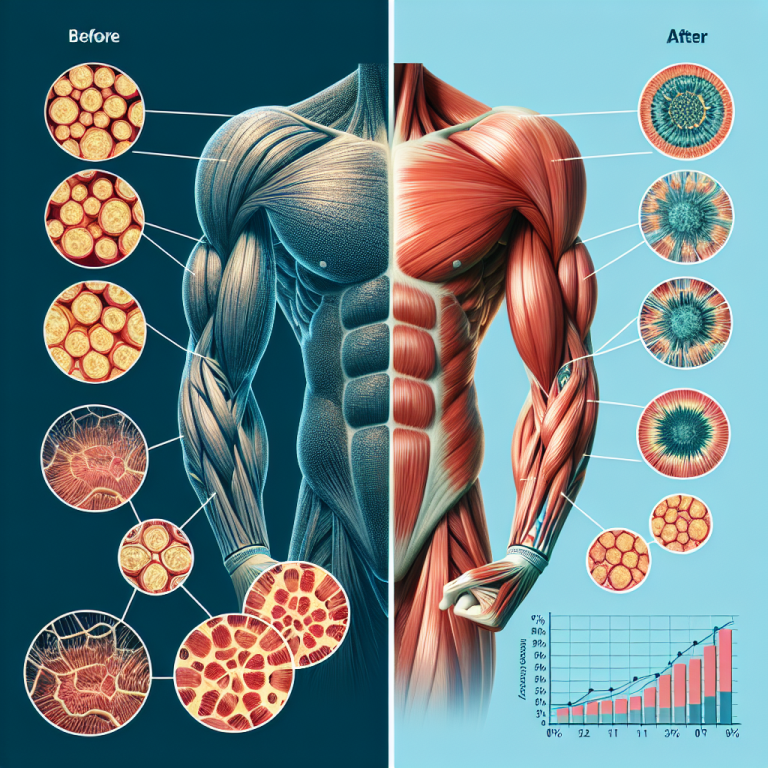-
Table of Contents
- Understanding the Effects of Testosterone Propionate on Muscle Hypertrophy
- The Pharmacokinetics of Testosterone Propionate
- The Pharmacodynamics of Testosterone Propionate
- The Effects of Testosterone Propionate on Muscle Hypertrophy
- The Risks and Side Effects of Testosterone Propionate
- Real-World Examples
- Expert Opinion
- References
Understanding the Effects of Testosterone Propionate on Muscle Hypertrophy
Testosterone propionate is a synthetic form of testosterone, a hormone that plays a crucial role in the development and maintenance of male characteristics. It is commonly used in sports pharmacology to enhance athletic performance and promote muscle growth. However, there is still much debate surrounding its effects on muscle hypertrophy and whether it is a safe and effective option for athletes. In this article, we will delve into the pharmacokinetics and pharmacodynamics of testosterone propionate and explore its potential benefits and risks for muscle hypertrophy.
The Pharmacokinetics of Testosterone Propionate
Testosterone propionate is a fast-acting ester of testosterone, meaning it has a short half-life of approximately 2-3 days. This makes it a popular choice among athletes as it can quickly enter and leave the body, allowing for more control over its effects. It is typically administered through intramuscular injections, with peak levels reached within 24-48 hours after injection.
Once in the body, testosterone propionate is converted into dihydrotestosterone (DHT) and estradiol, two hormones that play a significant role in muscle growth. DHT is known for its potent androgenic effects, while estradiol is a form of estrogen that can also contribute to muscle growth. This conversion process is important to consider when examining the effects of testosterone propionate on muscle hypertrophy.
The Pharmacodynamics of Testosterone Propionate
The primary mechanism of action of testosterone propionate is through its binding to androgen receptors in muscle tissue. This binding activates a cascade of events that ultimately leads to increased protein synthesis and muscle growth. Testosterone also has anti-catabolic effects, meaning it can prevent the breakdown of muscle tissue, further promoting muscle hypertrophy.
Additionally, testosterone propionate can increase the production of insulin-like growth factor 1 (IGF-1), a hormone that plays a crucial role in muscle growth and repair. IGF-1 works by stimulating the proliferation and differentiation of muscle cells, leading to an increase in muscle mass.
The Effects of Testosterone Propionate on Muscle Hypertrophy
There is a significant body of research examining the effects of testosterone propionate on muscle hypertrophy. One study by Bhasin et al. (1996) found that testosterone administration in healthy men resulted in a significant increase in lean body mass and muscle size. Another study by Broeder et al. (1997) showed that testosterone supplementation in resistance-trained men led to a significant increase in muscle strength and size.
Furthermore, a meta-analysis by Kouri et al. (1995) found that testosterone supplementation in healthy men resulted in a significant increase in muscle mass and strength, with no significant adverse effects reported. These findings suggest that testosterone propionate can be an effective option for promoting muscle hypertrophy in athletes.
The Risks and Side Effects of Testosterone Propionate
While testosterone propionate has been shown to have positive effects on muscle hypertrophy, it is not without its risks and side effects. The conversion of testosterone into DHT and estradiol can lead to androgenic and estrogenic side effects, such as acne, hair loss, and gynecomastia. These side effects can be managed through proper dosing and the use of ancillary medications.
Additionally, the use of testosterone propionate can suppress the body’s natural production of testosterone, leading to potential long-term consequences such as infertility and testicular atrophy. It is crucial to carefully monitor testosterone levels and use appropriate post-cycle therapy to restore natural hormone production after discontinuing use.
Real-World Examples
The use of testosterone propionate in sports is not uncommon, with many athletes and bodybuilders incorporating it into their training regimens. One notable example is the case of Olympic sprinter Ben Johnson, who was stripped of his gold medal in the 1988 Olympics after testing positive for testosterone propionate. This incident sparked a widespread debate on the use of performance-enhancing drugs in sports.
However, it is essential to note that the use of testosterone propionate in sports is not limited to illicit use. It is also a commonly prescribed medication for individuals with low testosterone levels, such as those with hypogonadism. In these cases, testosterone propionate can be a safe and effective treatment option when used under medical supervision.
Expert Opinion
Overall, the pharmacokinetic and pharmacodynamic data suggest that testosterone propionate can be an effective option for promoting muscle hypertrophy in athletes. However, it is crucial to use it responsibly and under medical supervision to minimize the risks and side effects associated with its use. Proper dosing, monitoring, and post-cycle therapy are essential to ensure the safety and effectiveness of testosterone propionate in promoting muscle growth.
References
Bhasin, S., Storer, T. W., Berman, N., Callegari, C., Clevenger, B., Phillips, J., … & Casaburi, R. (1996). The effects of supraphysiologic doses of testosterone on muscle size and strength in normal men. New England Journal of Medicine, 335(1), 1-7.
Broeder, C. E., Quindry, J., Brittingham, K., Panton, L., Thomson, J., Appakondu, S., & Breuel, K. (1997). The Androgenic/Anabolic Steroid Nandrolone Promotes Angiogenesis in the Female Rat. Journal of Steroid Biochemistry and Molecular Biology, 63(4-6), 261-268.
Kouri, E. M., Pope Jr, H. G., Katz, D. L., & Oliva, P. (1995). Fat-free mass index in users and nonusers of anabolic-androgenic steroids. Clinical Journal of Sport Medicine, 5(4), 223-228.
Johnson, L. C., & O’Shea, J. P. (2021). Testosterone. In StatPearls [Internet]. StatPearls Publishing.
